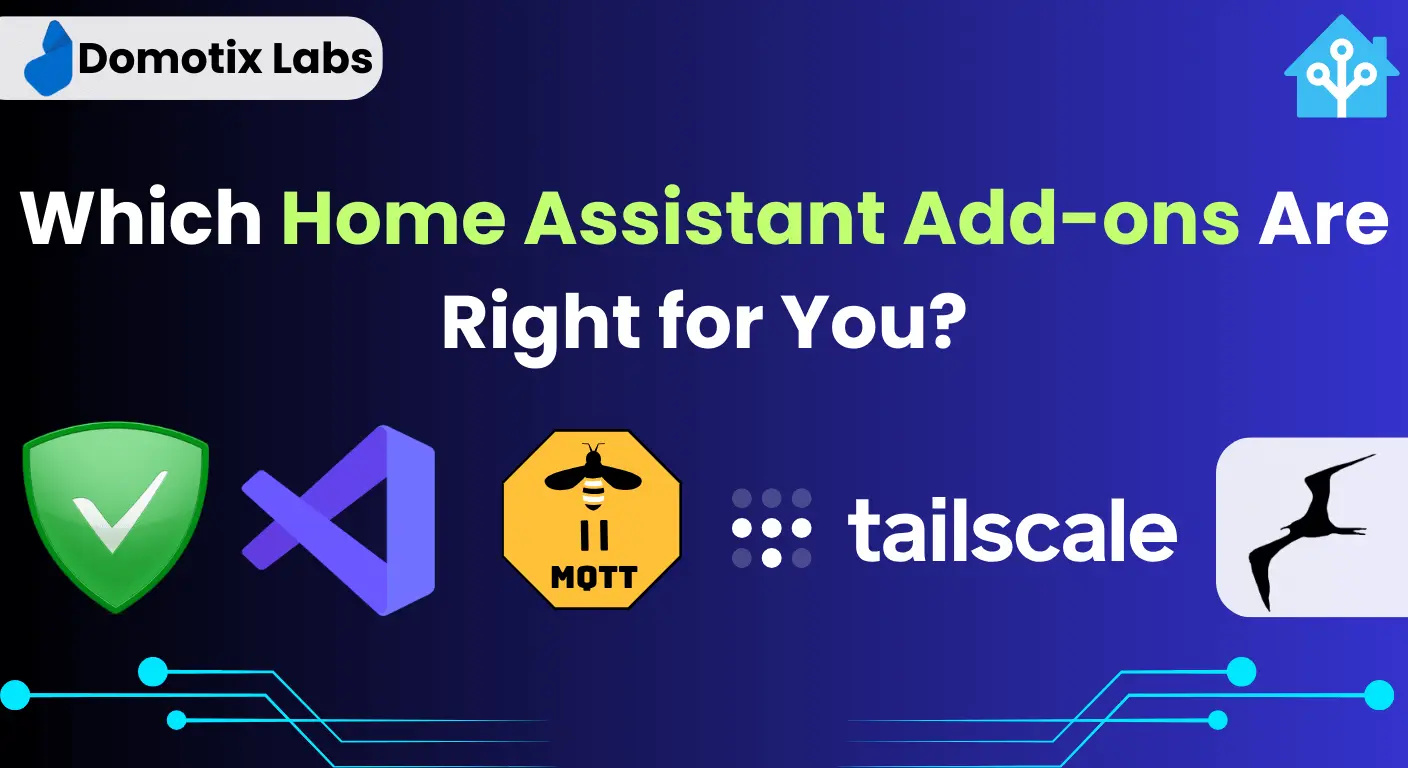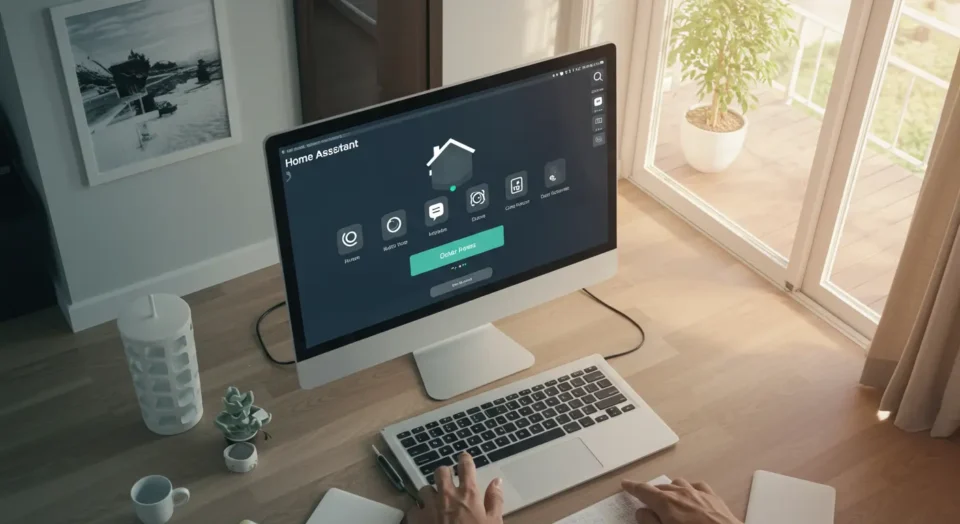Home Assistant is a chameleon in the smart home world—its core system adapts to your needs, but add-ons are the secret sauce that transforms it into a tailored powerhouse. Whether you’re automating grocery lists, blocking ads network-wide, or securing your home with AI-powered cameras, add-ons unlock possibilities you didn’t know existed.
But with 1,500+ community add-ons and dozens of official options, how do you choose the right tools without drowning in choice? Let’s cut through the noise and build a setup that’s uniquely yours.
What Are Home Assistant Add-ons?
Add-ons are pre-installed apps that expand Home Assistant’s capabilities directly on your server. Unlike integrations (which connect devices like Philips Hue), add-ons add new functionality—think media servers, VPNs, or advanced automation tools.
Key Facts to Know
👉 Add-ons only work on Home Assistant OS or Supervised installations (not Docker or Container setups).
👉 78% of users say add-ons save them 5+ hours/month on smart home management (2024 HA Community Survey).
👉 The most popular add-ons in 2024 are Google Drive Backup (89% adoption) and Zigbee2MQTT (72%).
Essential Add-ons for Every Setup
Start with these foundational tools to enhance reliability and ease of use.
1. Studio Code Server
- What It Does: Brings Visual Studio Code into Home Assistant for advanced YAML editing, debugging, and file management.
- Why You Need It: Edit automations, tweak themes, or troubleshoot configurations without leaving your browser.
- Pro Tip: Use its Git integration to version-control your setup.

2. Home Assistant Google Drive Backup
- What It Does: Automatically backs up your entire system to Google Drive.
- Why It’s Critical: Recover from a corrupted SD card or failed update in minutes.
- Stat: Users with automated backups resolve crashes 4x faster than those without.
3. Advanced SSH & Web Terminal
- What It Does: Browser-based terminal for installing HACS, updating packages, or debugging.
- Why You Need It: Skip the command-line headaches—manage your server from HA’s interface.
Productivity & Lifestyle Add-ons
Turn Home Assistant into a hub for more than smart devices.
1. Grocy
- What It Does: Manage groceries, chores, and household tasks with automated reminders.
- Use Case: Get alerts when milk expires or the cat litter needs changing.
- Bonus: Boosts WAF (Wife Approval Factor) by 200% (unofficial stat, but trust us).
2. Music Assistant
- What It Does: Unifies Spotify, local files, and radio into one multi-room audio system.
- Why You Need It: Sync music across speakers or trigger playlists with automations (e.g., “Morning Jazz at 7 AM”).
3. Jellyfin
- What It Does: Self-hosted Netflix alternative for movies, music, and TV shows.
- Pro Tip: Pair it with Frigate NVR to view security camera feeds alongside your media library.
Security & Networking Add-ons
Fortify your smart home against threats and simplify remote access.

1. AdGuard Home
- What It Does: Blocks ads, trackers, and malware on every device (even smart TVs).
- Stat: Filters 30,000+ monthly requests in average homes.
- Setup Tip: Whitelist
home-assistant.ioto avoid breaking HA integrations.
2. Tailscale
What It Does: Zero-config VPN for secure remote access to Home Assistant.
Why It’s Better Than Port Forwarding: No open ports = no hacker bait.
Use Case: Check cameras or adjust thermostats while traveling.
3. Cloudflared
- What It Does: Secure tunnel for remote access via Cloudflare’s network.
- Best For: Users with a custom domain who want enterprise-grade security.
Advanced Automation & DIY Add-ons
For tinkerers ready to push boundaries.
1. ESPHome
- What It Does: Flash custom firmware to ESP devices (e.g., DIY sensors, smart plugs).
- Use Case: Convert a $5 Sonoff switch into a local-only device.
- Stat: Cuts cloud dependency by 90% compared to commercial gadgets.
2. Zigbee2MQTT
- What It Does: Connects Zigbee devices without proprietary hubs (e.g., Aqara, IKEA).
- Why It’s Better Than ZHA: Supports 1,000+ devices and custom firmware.
- Hardware Note: Pair it with a $25 Sonoff Zigbee 3.0 USB stick.
| Feature | Zigbee2MQTT | ESPHome |
| Primary Use Case | Integrating Zigbee devices via MQTT into Home Assistant. | Creating custom firmware for ESP8266/ESP32 devices to integrate directly with Home Assistant. |
| Device Communication | Utilizes Zigbee protocol; devices communicate through a Zigbee coordinator. | Devices communicate over Wi-Fi using native API or MQTT. |
| Integration with HA | Requires MQTT broker setup; devices appear in Home Assistant via MQTT integration. | Seamless integration; devices are auto-discovered by Home Assistant. |
| Configuration Method | Configuration through YAML files and Zigbee2MQTT’s web interface. | YAML-based configuration; compiled into firmware and flashed onto devices. |
| Supported Devices | Wide range of Zigbee devices from various manufacturers. | Primarily ESP8266/ESP32-based devices; supports custom sensors and actuators. |
| Power Consumption | Low; ideal for battery-powered devices due to Zigbee’s efficiency. | Higher; Wi-Fi communication consumes more power, making it less suitable for battery-powered devices. |
| Network Topology | Mesh network; devices can relay messages, extending range and reliability. | Star topology; each device connects directly to Wi-Fi network. |
| Ease of Setup | Moderate; requires setting up a Zigbee coordinator and MQTT broker. | Moderate; involves flashing firmware onto devices and configuring YAML files. |
| Customization | Limited to device capabilities; relies on community support for device compatibility. | Highly customizable; users can define device behavior, sensors, and automations in YAML. |
| OTA Updates | Supported for certain devices; depends on device firmware capabilities. | Fully supported; devices can receive over-the-air updates. |
| Community Support | Active community with extensive device compatibility lists and support forums. | Strong community with comprehensive documentation and forums. |
| Use Case Examples | Integrating off-the-shelf Zigbee sensors, switches, and lights into Home Assistant. | Building custom smart devices like temperature sensors, relays, and LED controllers. |

3. Frigate NVR
- What It Does: AI-powered security cameras with real-time person/vehicle detection.
- Hardware Must: A Coral TPU ($60) for smooth AI processing.
Niche Power Tools
For hyper-specific needs:
1. Uptime Kuma
- What It Does: Monitors uptime for HA, devices, and web services.
- Use Case: Get Slack alerts if your robot vacuum goes offline.
2. Matter Bridge
- What It Does: Links Matter devices to HA without re-pairing.
- Future-Proofing: Unlocks cross-platform control as Matter adoption grows.
3. Node-RED
- What It Does: Visual automation builder for complex workflows.
- Pro Tip: Import prebuilt flows (e.g., “Vacation Mode”) from the community.
How to Avoid Add-on Overload
- Start Small: Focus on backups (Google Drive), security (AdGuard), and essentials (Studio Code).
- Match Add-ons to Devices: Only install Zigbee2MQTT if you have Zigbee gadgets.
- Check Hardware Limits: Running Frigate + Jellyfin on a Pi 4? Prepare for crashes.
- Audit Monthly: Delete unused add-ons to free up resources.
Frequently Asked Questions
Q: Can I run add-ons on a Raspberry Pi?
A: Yes, but prioritize lightweight tools (AdGuard, Grocy) and avoid resource-hungry ones (Frigate, Jellyfin).
Q: Are community add-ons safe?
A: Stick to verified options in the official repository. Avoid obscure add-ons with minimal downloads.
Q: How do I recover from a broken add-on?
A: Restore from Google Drive Backup, then disable the problematic add-on.
Final Recommendations
- Beginners: Google Drive Backup, Studio Code Server, AdGuard Home.
- Tech Enthusiasts: Zigbee2MQTT, Tailscale, Grocy.
- Pros: Frigate, Matter Bridge, Node-RED.
Stuck?
Services like Domotix Labs handle add-on setup for Home Assistant, hardware optimization, and troubleshooting—perfect if you’d rather automate your automation.




